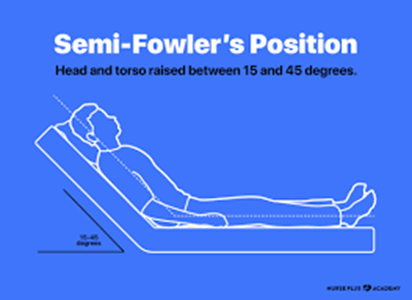A client 80 years of age experienced dysphagia (impaired swallowing) in the weeks following a recent stroke, but the care team wishes to now begin introducing minced and pureed food. How should the nurse best position the client?
Protective Supine
Semi-Fowlers
Low-Fowlers
Fowlers
The Correct Answer is B
Choice A rationale: Protective supine positioning is not ideal for managing dysphagia or facilitating swallowing.
Choice B rationale: Semi-Fowlers positioning, with the head of the bed elevated at a 30 to 45-degree angle, is often recommended for clients with dysphagia. This position helps prevent aspiration during eating and promotes effective swallowing.
Choice C rationale: Low-Fowlers and Fowlers positions may not be as effective in preventing aspiration during eating as the Semi-Fowlers position.
Choice D rationale: Fowlers positioning alone may not be sufficient for managing dysphagia; Semi-Fowlers is a more specific recommendation.

Nursing Test Bank
Naxlex Comprehensive Predictor Exams
Related Questions
Correct Answer is D
Explanation
Choice A rationale: Unintentional closed wounds involve blunt force trauma but do not typically result in jagged edges with muscle tissue visible.
Choice B rationale: Intentional closed wounds are typically surgical incisions and do not present with jagged edges and visible muscle tissue.
Choice C rationale: Intentional open wounds are typically surgical incisions, not the result of a biking accident.
Choice D rationale: Unintentional open wounds result from accidents and can present with jagged edges and visible tissue.
Correct Answer is A
Explanation
Choice A rationale: A purplish-colored stoma may indicate compromised blood supply and should be reported to the provider.
Choice B rationale: A shiny, moist stoma is a healthy characteristic of a colostomy. Choice C rationale: Stoma oozing red drainage is a normal finding after colostomy surgery.
Choice D rationale: "Budded" stoma is not a recognized term related to colostomy assessment.
Whether you are a student looking to ace your exams or a practicing nurse seeking to enhance your expertise , our nursing education contents will empower you with the confidence and competence to make a difference in the lives of patients and become a respected leader in the healthcare field.
Visit Naxlex, invest in your future and unlock endless possibilities with our unparalleled nursing education contents today
Report Wrong Answer on the Current Question
Do you disagree with the answer? If yes, what is your expected answer? Explain.
Kindly be descriptive with the issue you are facing.
